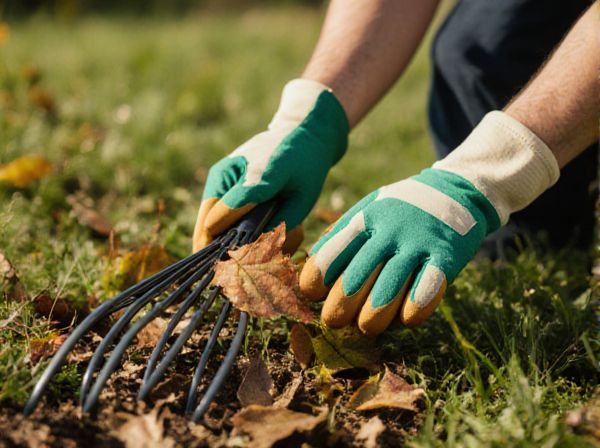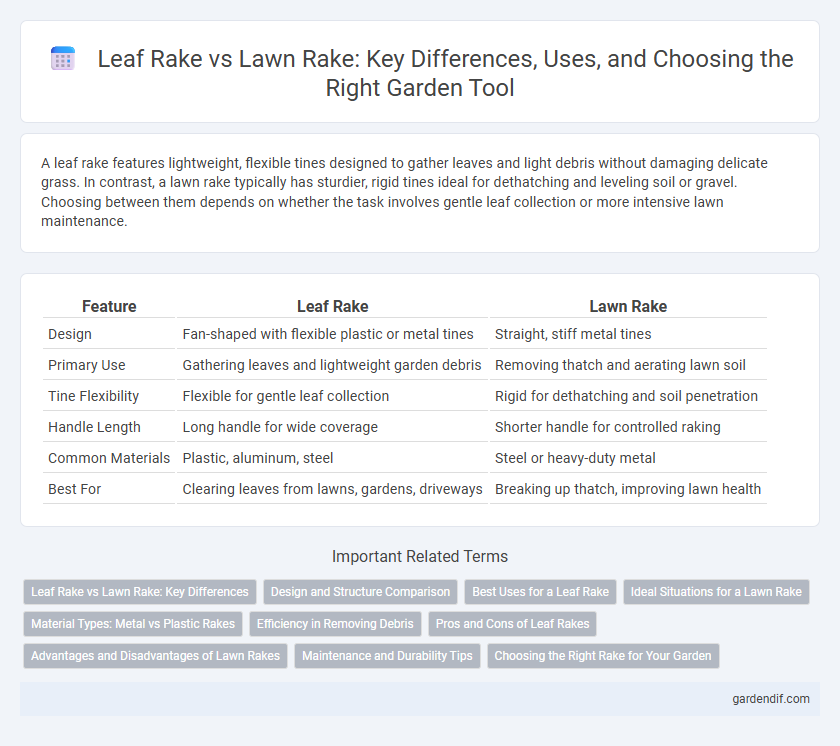
Leaf rake vs Lawn rake Illustration
A leaf rake features lightweight, flexible tines designed to gather leaves and light debris without damaging delicate grass. In contrast, a lawn rake typically has sturdier, rigid tines ideal for dethatching and leveling soil or gravel. Choosing between them depends on whether the task involves gentle leaf collection or more intensive lawn maintenance.
Table of Comparison
| Feature | Leaf Rake | Lawn Rake |
|---|---|---|
| Design | Fan-shaped with flexible plastic or metal tines | Straight, stiff metal tines |
| Primary Use | Gathering leaves and lightweight garden debris | Removing thatch and aerating lawn soil |
| Tine Flexibility | Flexible for gentle leaf collection | Rigid for dethatching and soil penetration |
| Handle Length | Long handle for wide coverage | Shorter handle for controlled raking |
| Common Materials | Plastic, aluminum, steel | Steel or heavy-duty metal |
| Best For | Clearing leaves from lawns, gardens, driveways | Breaking up thatch, improving lawn health |
Leaf Rake vs Lawn Rake: Key Differences
Leaf rakes feature a fan-shaped design with flexible, lightweight tines ideal for gathering leaves and small debris without damaging grass, while lawn rakes typically have sturdier, straight tines optimized for dethatching and removing thatch buildup. The tine spacing and material differ significantly, with leaf rakes using plastic or metal tines spread widely for surface-level collection, compared to the concentrated, robust metal tines of lawn rakes designed to penetrate thatch layers. Choosing between a leaf rake and a lawn rake depends on the specific lawn care task, highlighting the importance of tool selection based on rake structure and purpose.
Design and Structure Comparison
Leaf rakes feature flexible tines made of plastic or metal, designed to efficiently gather lightweight leaves and debris without damaging grass. Lawn rakes typically have sturdier, shorter, and widely spaced tines made of metal, optimized for dethatching and removing heavier debris like thatch and soil clumps. The broader head and rigid construction of lawn rakes provide durability and leverage, whereas leaf rakes emphasize lightweight design for ease of leaf collection.
Best Uses for a Leaf Rake
Leaf rakes are best used for gathering lightweight debris such as fallen leaves, grass clippings, and small twigs without damaging the lawn surface. Their flexible, fan-shaped tines allow for efficient collection on delicate surfaces and uneven terrain, making them ideal for garden maintenance and clearing yard waste. Unlike lawn rakes, leaf rakes are not designed for heavy-duty tasks like dethatching or soil leveling.
Ideal Situations for a Lawn Rake
A lawn rake is ideal for smoothing soil, leveling mulch, and preparing garden beds, thanks to its flexible metal tines that prevent soil damage. Unlike a leaf rake designed for gathering lightweight leaves, a lawn rake excels in breaking up compacted earth and spreading heavy materials evenly. Homeowners and landscapers prefer lawn rakes for detailed lawn maintenance and garden bed preparation tasks.
Material Types: Metal vs Plastic Rakes
Leaf rakes typically feature lightweight plastic tines that resist clogging and are ideal for delicate lawns, while lawn rakes often use durable metal tines designed for heavy-duty tasks like dethatching and soil preparation. Metal rakes provide superior strength and longevity, making them suitable for tougher debris and rougher terrain. Plastic rakes offer flexibility and rust resistance, ensuring ease of use and maintenance in lighter yard work.
Efficiency in Removing Debris
Leaf rakes feature flexible, fan-shaped tines designed to efficiently gather lightweight leaves and grass clippings over broad areas without damaging the lawn. Lawn rakes have sturdier, closely spaced metal tines optimized for removing heavier debris like thatch and small sticks, effectively preparing the soil for aeration. Choosing between leaf rake or lawn rake depends on the type of debris and desired precision in clearing, impacting cleanup speed and lawn health.
Pros and Cons of Leaf Rakes
Leaf rakes, designed with flexible, fan-shaped tines, excel at gathering lightweight debris like leaves without damaging delicate grass, making them ideal for fall cleanup. Their lightweight construction offers ease of use and maneuverability, but the flexible tines can struggle with heavier materials or wet leaves, reducing efficiency. Unlike lawn rakes, leaf rakes are less effective for tasks requiring soil or thatch disruption and are not suitable for heavy-duty yard work.
Advantages and Disadvantages of Lawn Rakes
Lawn rakes feature flexible, fan-shaped tines designed to gather grass clippings and light debris without damaging the turf, promoting lawn health and reducing thatch buildup. Their lightweight structure allows for easy maneuverability and efficient removal of small debris, but they tend to be less effective on heavy, wet leaves or larger debris compared to leaf rakes. The primary disadvantage lies in their limited capacity to handle larger, coarse materials, making them less versatile for extensive leaf cleanup tasks.
Maintenance and Durability Tips
Leaf rakes typically require regular checking and tightening of tines to maintain optimal performance, while lawn rakes benefit from sturdy, flexible metal tines that resist bending under heavy use. Proper storage, such as hanging leaf rakes off the ground and keeping lawn rakes dry, prevents rust and extends tool life. Replacing worn or damaged parts promptly enhances durability and ensures efficient maintenance for both types of rakes.
Choosing the Right Rake for Your Garden
Choosing the right rake for your garden depends on the specific tasks and the type of debris you need to manage. Leaf rakes feature flexible, fan-shaped tines ideal for gathering lightweight leaves and grass clippings without damaging delicate plants. Lawn rakes, on the other hand, have sturdier, short metal tines designed for dethatching and removing heavier debris like dead grass and soil clumps from lawns, ensuring healthy turf maintenance.
Leaf rake vs Lawn rake Infographic

 gardendif.com
gardendif.com